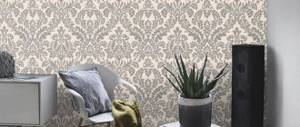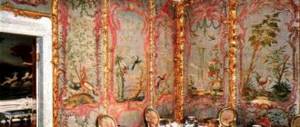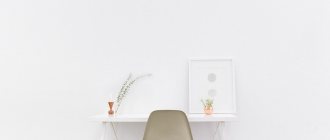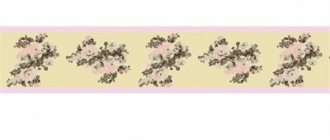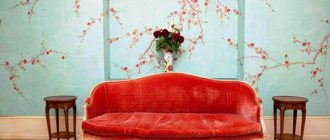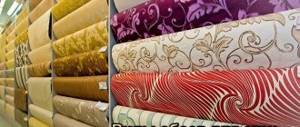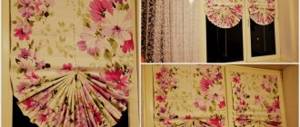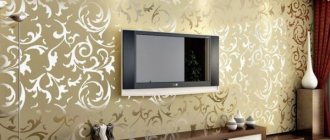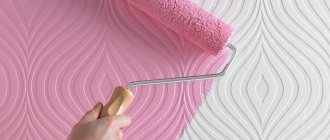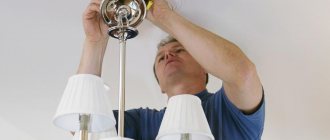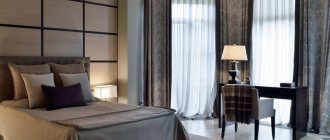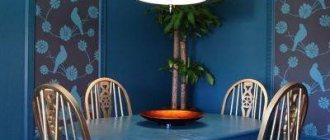The desire to diversify your interior without resorting to overly expensive finishing materials has led to the growing popularity of wall decorations such as wallpaper with photographic images. No less responsible than the selection or production of the coating itself is the choice of such an important component as adhesive for photo wallpaper. It largely determines how exactly the finish will look and how long it will last.
What glue is suitable for photo wallpaper
As a rule, when purchasing a ready-made set of photo wallpapers, we receive instructions for handling this specific type of coating. It also contains information on what kind of glue to use for wallpaper and how to prepare it correctly. Most manufacturers of wallpaper with photographic images recommend a highly specialized adhesive that is most suitable for “their” type of canvas.
For modern photo wallpapers, two types of glue are used:
- for light wallpaper - paper;
- for heavy fabrics - based on non-woven fabric, vinyl, textiles, etc.
When choosing an adhesive composition for photo wallpaper, you should pay attention to the degree of its moisture resistance, which can be increased by adding PVA glue to the finished solution (approximately 10–15%). But when using such a mixture, you need to be prepared for the fact that during subsequent repairs it will be much more difficult to remove the old coating, since this glue increases the adhesion of the wallpaper to the wall.
Important! As practice shows, universal wallpaper adhesive holds only light paper or vinyl wallpaper of medium weight; this composition is not suitable for non-woven wallpaper, textile and other heavy fabrics.
A component of many types of modern glue are ready-made antiseptic additives that prevent the formation of fungus and mold under wallpaper. These components allow you to use wallpaper with photo printing in rooms with high humidity.
Important! You should pay attention that the diluted adhesive solution is homogeneous after infusion and does not have a strong unpleasant odor.
It would not be amiss to remind you that the glue should be diluted and used strictly according to the instructions, carefully observing the proportions, dilution method and infusion time, since such properties of the adhesive composition as stickiness and adhesion and, accordingly, the result of painstaking work directly depend on this.
USEFUL INFORMATION: Choosing fiberglass wallpaper for painting
Note! When working with any wallpaper glue, there is a general rule - the heavier and thicker the wallpaper, the thicker the adhesive solution should be.
How to dilute wallpaper glue correctly?
Most wallpaper adhesives based on starch and methylcellulose are sold as a dry mixture. What to mix with and how to dilute this mixture?
- To prepare any glue you will need a spacious basin or bucket, a sufficient amount of water and the dry mixture itself. In addition, prepare in advance the object with which you will stir the glue - it can be an ordinary stick or a construction mixer.
- Read the instructions on the package - it will indicate in what ratio to mix dry powder with water.
- First, water is poured into the container, then glue is poured. It is recommended to take slightly warm water - about 25ºС. It is better if, when adding glue, you simultaneously stir the water in a circle - this way the mixture will be better distributed in the container.
- Having poured the required amount of solution, mix the glue for another 5 - 10 minutes - until you are sure that there are almost no lumps left in the finished mixture. After this, leave the glue to stand for about half an hour.
See also: Tile adhesive - which one to choose?
What glue consistency is considered optimal? It depends on the type of wallpaper, but in general, liquid compositions are only suitable for gluing paper sheets. For vinyl, non-woven and especially fabric wallpapers, it is recommended to use thick glue applied to the wall in a dense layer.
If you are not sure that you can achieve the desired consistency of glue the first time, try to make the mixture too thin rather than too thick. Gently diluting the mixture with water is much easier than pouring additional glue into the container.
Glue for non-woven photo wallpaper: features and application rules
When gluing photo wallpaper on a non-woven basis, you should use a strictly special glue, the peculiarity of which is an important nuance: it is not applied to the wallpaper, but only to the wall.
A high-quality special adhesive for non-woven coatings should:
- spread quickly and evenly;
- have a long shelf life before preparation and several days in diluted form (in a closed container);
- be safe to use and harmless to health;
- have a coloring pigment (usually pink or blue), which allows you to control the uniformity of application;
- be economical to use.
This adhesive solution is prepared simply and quickly: the dry substance is poured with the required amount of water (observing the temperature and proportions) and infused for 5–10 minutes with occasional stirring. Next, a section of the wall is covered with the prepared mixture and a fragment of photo wallpaper is immediately applied to it, straightened and leveled.
Important! Non-woven fabrics to be glued must be dry.
Universal glue made from flour for wallpaper
Main components of the compositions
In many old buildings, seeing perfectly papered rooms, we cannot imagine that twenty years ago the preparation of wallpaper glue was carried out in the kitchen of this apartment. The main components of the compositions were:
- potato starch;
- flour (rye or wheat).
The adhesive properties of potato starch and flour gluten have been known since ancient times, and when additional components are added, they increase significantly.
DIY wallpaper glue made from flour
If you spend a little time (about half an hour) you can produce an inexpensive, high-quality product that is not inferior to an industrial one. Its basis is wheat gluten flour, which is sold in stores and is very cheap.
The first composition is a paste for wallpaper and paper:
- take flour (calculation – 2 tablespoons per 1 liter of water);
- pour warm water into a container and stir the flour in it;
- put on low heat and cook for five minutes.
This product is used for gluing wallpaper, as well as joining paper and cardboard.
The second composition is wallpaper glue made from flour:
- take flour (calculation – 1 part to 3 parts water);
- pour the flour into a container (large pan or bucket);
- pour plain water and stir until the mass becomes homogeneous;
- put the container on the stove and cook over very low heat until it boils, stirring constantly;
- after boiling, remove from heat, strain and cool;
- the composition is ready.
As you can see, this work is not labor-intensive and simple. You can check the quality like this: take the resulting mass with two fingers. The composition should drain. If this is not the case, you need to add a little warm water and stir.
Squeeze the mixture between your fingers and then slowly unclench them. If you feel some stickiness and elasticity when you open your fingers, then the composition is ready. If this does not happen, you need to add flour and repeat the process again.
DIY wallpaper glue made from starch
Some ingredients (for example, turpentine) used in formulations based on potato starch are now very difficult to obtain. Therefore, it is easier to make glue using alcohol.
For regular walls:
- mix 750 g of potato starch in 200 ml of denatured alcohol or wood alcohol;
- pour in 1.5 liters of water and stir;
- add 8-9 liters of boiling water;
- bring the mixture to a boil;
- separately from this, dissolve 100 g of alum in 0.3 liters of water;
- add alum solution to the resulting mixture and stir;
- the resulting composition is cooled and filtered.
For damp walls.
- dilute 40 g of calcium chloride in 600 g of water;
- bring to a boil;
- Mix 400 g of water and 400 g of potato starch separately;
- A solution of boiling calcium chloride is poured into this mixture and mixed;
- the resulting mixture is heated and 4-5 liters of hot water are added;
- 2-3 boil.
- 1 kg of rye flour is soaked in 2 liters of water;
- add 8-9 liters of heated water;
- bring to a boil;
- filter;
- add 600 g of turpentine and stir.
Adhesive for vinyl wallpaper on non-woven and paper backing
Vinyl photo wallpaper is a polyvinyl chloride film on a paper or non-woven base. The type of adhesive used to attach vinyl coverings depends on the type of substrate.
- For vinyl on a non-woven base, adhesive for heavy vinyl wallpaper is suitable, which must contain a bactericidal component, since the vinyl film does not allow air circulation, i.e., an environment favorable for the proliferation of microorganisms is created. The process of working with glue is the same as in the case of non-woven wallpaper, and the gluing method is similar - the adhesive composition is applied to the wall fragment and a dry sheet is applied.
- Vinyl photo wallpapers on a paper base are glued both to non-woven adhesive with the same properties, only a little more liquid, and to a special one designed for lightweight vinyl sheets. Only it is applied not to the work surface, but to the wallpaper sheet. Despite the paper backing material, it is better not to use a universal composition for gluing paper wallpaper in this case, as it will not withstand the weight of the polyvinyl chloride film.
USEFUL INFORMATION: Is it necessary to prime drywall before wallpapering: what to treat with
How to properly glue different types of wallpaper
The overall impression of the room will depend on how you wallpaper the walls. Even the most expensive and beautiful wallpaper can ruin the interior if it is poorly glued. In order not to waste time and not spoil the wallpaper, listen to our advice.
- 1 of 1
On the picture:
You can often hear the question: how to glue vinyl wallpaper, paper or non-woven wallpaper? How to glue is not an idle question. The fact is that all of the listed types of wallpaper are glued differently.
Composition for gluing paper wallpaper with a photo image
Paper wallpaper is the “lightest” wall covering, both literally and in operation. For this type of photo wallpaper, special glue is also preferable to universal glue, and its calculated amount depends on the thickness of the canvas. In this case, the adhesive solution is applied to the paper web, which is then left for several minutes to soak (in folded form). Then carefully, without stretching, you need to stick it on the wall, level it and remove air or possible excess adhesive mass.
Advice. It is better to coat thin fabrics with cold adhesive, and two-layer or foam ones with warm adhesive.
Two groups of adhesive solutions
Depending on the scope of application, all types of wallpaper glue are divided into two large groups:
- Special compounds. They are produced for wallpaper made from a specific base material (for example, non-woven or vinyl, etc.), since they are best optimized for gluing a specific type of canvas. As a rule, the purpose is indicated by the manufacturer directly on the packaging or in the attached instructions.
- Universal compositions. They can be used for gluing almost any type of wallpaper. Many domestic companies producing similar products achieve an acceptable price-quality ratio.
Glue can be special or universal
As a rule, for greater clarity, manufacturers not only label such products with separate symbols, but even use packaging with different designs or colors.
Adhesive for textile photo wallpaper
Textile photo wallpaper is the heaviest type of wallpaper that does not shrink. They require a special high-quality dispersion adhesive with improved adhesion, moisture-resistant and free of color pigment. Often such an adhesive solution is sold ready-made, that is, diluted. When working with such a finishing material, the adhesive composition is applied either to the wall or to the canvas.
Rules for applying wallpaper glue
So, you purchased wallpaper, selected the appropriate glue and diluted it in a bucket according to all the rules. Now it's time to start applying it.
- To apply wallpaper glue, it is recommended to use a special wide brush or wallpaper roller. With their help, you can apply the glue as evenly and quickly as possible.
- If you apply glue to the wallpaper itself, then you need to coat the canvas from the center to the edges. If only a wall is being processed, or a wall and a piece of wallpaper at the same time, then glue is applied to exactly the area that is directly intended for gluing.
Is it better to apply glue to the wallpaper, to the wall, or should we treat both the surface and the wallpaper? This again depends on the type of wallpaper.
For example, paper webs require direct treatment with glue - they need to be saturated with the adhesive composition and slightly swollen. If you glue dry paper wallpaper to a wall coated with glue, it will swell during the drying process - and accordingly, it will wrinkle and bubble.
But in the case of vinyl, non-woven and fabric canvases, most often only the wall is processed. The glue is applied to it in a dense, even layer, and the canvas is simply applied on top and pressed. To find out how best to stick the wallpaper you bought, it’s worth studying the packaging - usually the manufacturer makes a special marking in the form of a brush directed “towards the wall” or “towards the wallpaper”.
After gluing any wallpaper, the wall should be carefully smoothed with a cloth or soft roller. This way you will prevent the appearance of bubbles, and at the same time collect excess glue that will inevitably appear at the joints.
Drying times for adhesives can vary widely. Typically, glue for paper wallpaper dries from a day to three, for vinyl wallpaper - about two days, for non-woven wallpaper - a day or two. But the drying speed of the glue directly depends on the room temperature. By the way, it is not recommended to artificially increase the temperature, much less ventilate the room - this will negatively affect the quality of work.
See also: Gypsum plaster
How much does diluted glue cost?
Although diluting the dry mixture before wallpapering is not the most difficult task, many are afraid of making a mistake or simply do not want to spend time preparing the mixture . In this case, you can immediately purchase ready-made glue - most manufacturers, and in particular KLEO, Quelyd, Metylan, offer customers diluted modifications.
How much does ready-made glue cost? As a rule, its cost is about 3 times higher than the price of the dry mixture. If a regular adhesive mixture in powder form costs about 300 rubles, then ready-made glue will cost 900 rubles or more. However, for this money you will receive high-quality glue of ideal consistency, ready for use.
Composition for gluing wallpaper joints
Poorly glued joints and edges of photo wallpaper can negate all design efforts, so on such wallpaper it is especially justified to use special glue for joints.
Means for gluing joints “Cleo”
Means for joints "Methylane"
A universal product used for all types of wall coverings, it dries quickly and becomes completely transparent. Sold ready to use in easy-to-use packaging, it is also ideal for minor restoration repairs.
